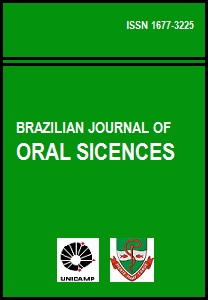Abstract
Toothpastes usually contain detergents, humectants, water, colorant, fluoride and thickeners (e.g.: silica). Tooth wear has a multi-factorial etiology and the use of abrasive dentifrices is related to abrasion of dental tissues during toothbrushing. This study evaluated in vitro the abrasiveness of a commercial silica gel low-abrasive dentifrice compared to an experimental dentifrice containing vegetable (almond) oil. Distilled water served as a control group. Acrylic specimens (8 per group) were submitted to simulated toothbrushing with slurries of the commercial dentifrice, experimental dentifrice, almond oil and water in an automatic brushing machine programmed to 30,000 brush strokes for each specimen, which is equivalent to 2 years of manual toothbrushing. Thereafter, surface roughness (Ra) of the specimens was analyzed with a Surfcorder SE 1700 profilometer. Data were analyzed statistically by ANOVA and Tukey’s test at 5% significance level. There was no statistically significant difference (p>0.05) in the surface roughness after brushing with water, almond oil or experimental dentifrice. The commercial dentifrice produced rougher surfaces compared to the control and abrasive-free products (p<0.05). Further studies are necessary to confirm the potential benefits of using vegetable oil in toothpastes as an alternative to abrasives in an attempt to minimize the tooth wear caused by toothbrushing.References
Löe H, Kleinman DV. Dental Plaque Control Measures and Oral Hygiene Practices. Oxford: IRL Press; 1986; 332p.
Bueno MAM, Toledo S, Sallum EA, Nociti Junior FH. Influência da escovação dental orientada na redução do sangramento gengival, em áreas próximas a restaurações metálicas. Rev ABO Nac. 1998; 6: 44-7.
Andrade Junior ACC, Andrade MRTC, Machado WAS, Fischer RG. Abrasividade de dentifrícios: Revisão de literatura. Rev Periodontia. 1997; 6: 25-30.
Baxter PM, Davis WB, Jackson J. Toothpaste abrasive requirements to control naturally stained pellicle. J Oral Rehabil. 1981; 8: 19-26.
Hefferren JJ, Schemehon B, Storek A, Lerck M, Li N. Silica as a reference for laboratory dentifrice assessment methods: multiple collaborative study. J Clin Dent. 2007; 8: 12-6.
Stookey G, Muhler J. Laboratory studies concerning the enamel and dentin abrasion properties of common dentifrice polishing agents. J Dent Res. 1968; 47: 524-32.
Glantz PO, Larsson LA. Surface roughness of composite resins before and after toothbrushing. Acta Odont Scand. 1972; 30: 335-47.
Prampero AL, Lara EHG, Tostes RCA, Ogasawara MS, Panzeri H. Relação das escovas com dentifrícios: estudo da interação de escovas dentais de diferentes tipos de cerdas com preparações básicas para dentifrícios. RGO. 1992; 40: 298-302.
Slop D, Rooij JF, Arends J. Abrasion of enamel. I. An in vitro investigation. Caries Res. 1983; 17: 242-8.
Heath J, Wilson J. Abrasion of restorative materials by toothpaste. J Oral Rehabil. 1976; 3: 121-38.
Patrão FGD, Sinhoreti MAC, Consani S, Correr Sobrinho L, Milan FM. Avaliação in vitro da rugosidade produzida por escovas dentais e dentifrícios em resina para base de prótese. Rev Fac Odontol Univ Passo Fundo. 1998; 3: 7-14.
Correr Sobrinho L, Francisco MU, Consani S, Sinhoreti MAC,Consani RLX. Influência da escovação na rugosidade de superfície de materiais restauradores estéticos. PGR Pós-Grad Rev Fac Odontol São Jose dos Campos. 2001; 4: 47-55.
Lara EHG, Panzeri H, Ogasawara MS, Ciampo JOD, Moraes JT. Avaliação laboratorial dos dentifrícios comerciais. Rev ABO Nac. 1996; 4: 176-80.
Addy M, Goodfield S, Harrison A. The use of acrylic to compare the abrasivity and stain removal proprieties of toothpastes. Clin Mater. 1991; 7: 219-25.
Addy M. Evaluation of clinical trials of agents and procedures to prevent caries and periodontal disease: choosing products and recommending procedures. Int Dent J. 1995; 45: 185-96.
Shaw L, al-Dlaigan YH, Smith A. Childhood asthma and dental erosion. J Dent Child. 2000; 67: 102-6.
Al-Dlaigan YH, Shaw L, Smith AJ. Is there a relationship between asthma and dental erosion? A case control study. Int J Paediatric Dent. 2002; 12: 189-200.
Aguiar AAA, Moraes Filho FC. A interferência do óleo vegetal na aderência da placa bacteriana dental. Rev Cienc Odontol. 1998; 1: 21-5.
Aguiar AAA, Saliba NA. Toothbrushing with vegetable oil: a clinical and laboratorial analysis. Braz Oral Res. 2004; 18: 168-73.
Meneghim MC, Pereira AC, Silva FRB. Prevalência da cárie radicular e condição periodontal em uma população idosa institucionalizada de Piracicaba – SP. Pesqui Odontol Bras. 2002; 16: 50-6.
Fransson C, Berglundh T, Lindhe J. The effect of age on the development of gingivitis. Clinical, microbiological and histological findings. J Clin Periodontal. 1996; 23: 379-85.
Lima FAP, Góes MF, Consani S. Avaliação “in vitro” da ação abrasiva de escovas dentais. Odonto. 1998;3:23-7.
Santos PH. Avaliação da porosidade interna e da rugosidade de superfície de resinas compostas para dentes posteriores submetidas à escovação. [Master’s thesis]. Piracicaba-SP: Piracicaba Dental School/UNICAMP; 2000. 180p.
Moore C, Addy M. Wear of dentin in vitro by toothpaste abrasives and detergents alone and combined. J Clin Periodontol. 2005; 32: 1242-6.
Joiner A, Pickles MJ, Tanner C, Weader E, Doyle P. An in situ model to study the toothpaste abrasion of enamel. J Clin Periodontol. 2004; 31: 434-8.
Figueiredo MC, Bello D. Avaliação comparativa entre a eficácia de uma escova alternativa e uma escova convencional na remoção de placa dentária. Rev Fac Odontol Univ Passo Fundo. 1999; 4: 13-20.
The Brazilian Journal of Oral Sciences uses the Creative Commons license (CC), thus preserving the integrity of the articles in an open access environment.

